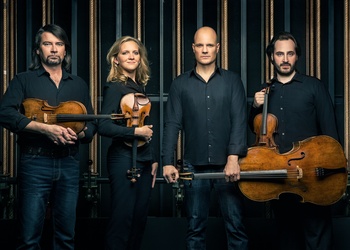Artemis Quartet presents stunning performance at Rackham

Artemis Quartet publicity photo
That’s the short story on the University Musical Society debut of the Berlin-based Artemis Quartet, which played a spectacular and spectacularly moving concert at Rackham Auditorium Wednesday evening.
The longer story involves four soloist-caliber players—Vineta Sareika, first violin; Gregor Sigl, second violin; Friedemann Weigle, viola; and Eckart Runge, cello—offering a program that promised a lot on paper and offered way more on stage.
It was a program that was tied together neatly as a Bach fugue; indeed, counterpoint was its underpinning. There was Mendelssohn—that great Bach champion—to begin and end; and, in between, music of Bach and Piazzolla, composers divided by eras and musical pigeonholes, but united by rigor, dance and polyphony. The encore was the “Presto Magico” from the Ginastera String Quartet No. 2, a link back to Piazzolla, who got a lot of his Bach training from this Argentine master.
Intellectual cohesiveness can take a program only so far, though. This one went the distance, emotionally and technically.
The Mendelssohn quartets were a study in contrasts. The opening quartet, No. 3 in D Major, Op. 44, No. 1, is as sunny as Mendelssohn is wont to be; the closing one, No. 6 in f minor, Op. 80, dark and stormy.
The players skimmed and danced in the first, playing with the most suave vocal quality, the most exquisite tuning, and a vast and nuanced dynamic palette that was never forced at its extreme ends. More than that, fortes and pianos were not mere effects, applied for show; always, they conveyed emotional color and depth.
In the second Mendelssohn, tempests did more than hover, they descended, and grit and grief were demanded as much as a mournful loveliness—provided in an elegiac Adagio that was warm, heartbreakingly beautiful and beautifully wrought.
The players’ freedom and their easy interplay—abetted, one sensed, by standing to play (with cellist Runge sitting on a podium)—came along with the best kind of restraint. When Runge, introducing the program’s central section of Bach and Piazzolla, talked about the non-exclusivity of rigor and emotion (we tend, he noted, to associate the former with Bach, the latter with Piazzolla), it seemed equally apt to apply the bond to the quartet’s style as to the music at hand.
Certainly, in the suite the quartet crafted from Bach preludes and fugues (from “Art of the Fugue” and “The Well-Tempered Clavier”) and Piazzolla tangos (from his “Angel” series), rigor and emotion went hand-in-hand. Without forcing Bachian style on Piazzolla or Piazzollan style on Bach, the quartet found a way of knitting the two into the same sound world. They played the pieces attacca, one sliding into the next, and musical bridges they composed created seamless, and startlingly subtle interleavings of the alternating Bach and Piazzolla selections. It really read as one large work, with the high point Piazzolla’s devastating “Milonga del Angel,” dark, quiet, narrow in sound, wide in scope.
If you were impressed, in the body of the concert, with the colors the quartet could conjure, the encore simply sealed the deal. It was a “Presto Magico” for sure that they offered, filled with flickerings, slides and pizzes, scamperings and scratchings and whistles. A fine end to an evening that was magical from start to finish.


Comments
Meggie53
Sat, Mar 16, 2013 : 1:22 p.m.
It was an outstanding evening. The talent and stamina of the performers beyond belief. Bravo